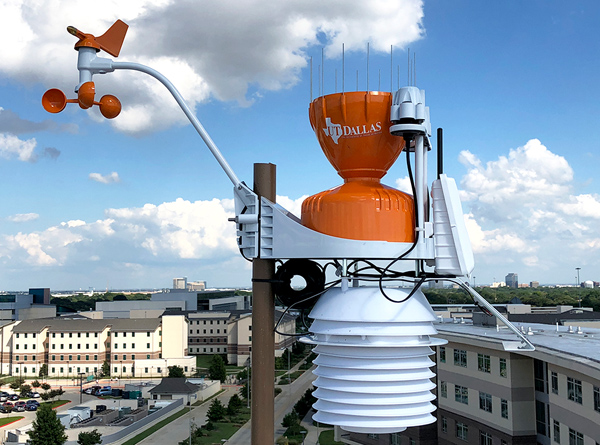
The new WeatherSTEM station is among the tools that emergency management officials Angela Dees (left) and Mariah Armitage use to keep the campus community informed about potentially severe weather. The station’s dashboard provides the latest information on conditions, including the temperature, wind gust, barometer, dew point, heat index, rain total and closest lightning.
A new weather station at The University of Texas at Dallas will help track inclement weather and its possible impact on the campus community. And self-described “preparedness-junkie” Angela Dees is in her element.
“I’ve been obsessed with weather since I was 5,” the emergency management specialist at UT Dallas recalled. “I was the one who had the mattress and the pillows in the tub first whenever a tornado warning siren blared.”
The new WeatherSTEM station provides a micro-local forecast and current weather information for the University and the surrounding area. The station, installed on top of Residence Hall West, has additional cameras facing north atop the Natural Science and Engineering Research Laboratory and south and west on a Canyon Creek Heights apartment building.

The station, on top of Residence Hall West, has additional campus cameras on the Natural Science and Engineering Research Laboratory and a Canyon Creek Heights apartment building.
“This is so cool. We are now able to get an accurate forecast for the campus area instead of having to type in our 75080 ZIP code and getting the other side of North Central Expressway,” Dees said.
UT Dallas students, faculty and staff can click on the weather station’s dashboard to see views of the horizon and get the latest information on conditions, including the temperature, wind gust, barometer, dew point, heat index, rain total and closest lightning.
The station provides real-time data to help with decisions about such things as delaying classes, canceling an on-campus event or postponing an athletic game, said Mariah Armitage, director of emergency management and continuity planning.
“This will help us make decisions quicker because it gives specific information for our location,” she said. “When severe weather is blowing in, this will help us determine what part of campus will be affected. Students will have a chance to move their cars, and the University can better protect its vehicle fleet. The more heads-up we give to the campus community, the safer we keep our students.”
The station also will provide automatic alerts about severe weather to key University administrators who can then communicate to students, faculty and staff.
“I think this is invaluable to the campus community. It takes human error out of the equation,” Armitage said.
“When severe weather is blowing in, this will help us determine what part of campus will be affected. Students will have a chance to move their cars, and the University can better protect its vehicle fleet. The more heads-up we give to the campus community, the safer we keep our students.”
Mariah Armitage, director of emergency management and continuity planning at UT Dallas
The National Weather Service (NWS) is able to tap information from the station, and area residents can access it via a link on the city of Richardson’s website. All weather information from the station is recorded and archived so viewers can compare weather patterns on different dates.
The station is part of the University’s preparedness plan for local hazardous weather, Armitage said. UT Dallas already partners with the NWS’ emergency exercises and has implemented its StormReady Program guidelines, which include establishing a 24-hour warning point and emergency operations center, training severe-weather spotters and holding emergency exercises.
Dees coordinated the installation of the weather station and credited Facilities Management, the Office of Information Technology, the Division of Student Affairs and others for helping secure the best locations for the cameras.
Dees considers herself lucky to have a career that requires her to stay on top of the weather. While studying meteorology at the University of South Alabama, she was a member of a storm- chasing club that investigated tropical depressions and other severe weather. She switched majors when she realized she would rather help people prepare for a storm than forecast one and completed a degree in emergency administration and planning instead.
Though Dees knows weather is not everyone’s passion, she knows it affects everyone.
“Our lives revolve around the weather, whether we like it or not,” said Dees, who even named her cat Doppler.